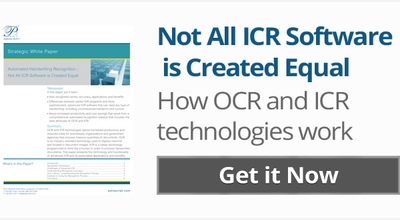Intelligent Character Recognition (ICR) converts hand printed characters to their machine print (ASCII) equivalents, representing a significant step forward in technology when compared to OCR systems that only read machine print. The ability to recognize handprint significantly broadens the range of applications that benefit from automated ICR solutions. Because ICR can handle variations in character shape, the term ‘intelligent’ is combined with ‘character recognition’ to describe handprint recognition.
ICR software is sometimes used in combination with OCR software in document and forms processing. While OCR software is able to read unstructured machine-printed text of good quality, typically ICR software has strict forms design requirements. However, advanced ICR software is able to read any type of handwriting, including unconstrained handprint and even cursive.
First ICR Software
First ICR software employed a topological approach to recognition. The term ‘topological’ is broadly defined as including curve tracing, feature analysis, matrix matching and topological recognologies. Besides this approach virtually every ICR software or “engine” in today’s marketplace involves some kind a self-learning system referred to as a neural network. To some extent, neural network engines emulate the way humans think. They can be trained to accurately recognize instances of highly variable patterns like hand print by exposing them to a multitude of examples of hand print characters.
Principles of ICR Technology
Hand printed characters are created by humans, so understanding and interpreting the patterns of human writing is far more complicated than converting simple machine print, because no two people ever write identical characters. Factors such as mood, environment, or stress all conspire to create variations in character writing, causing individuals to form characters differently each time they write or fill out a form. Variations will even appear within the same word, depending on where a character appears. Also, keep in mind that hand printed characters are never evenly spaced across the page, making it difficult for recognition systems to reliably segment words into their component characters.
People read text by scanning entire words, not individual characters. When a person is not clear about, say, whether a character is a ‘U’ or a ‘V’, he or she makes a decision based on context rather than the shape of the character. ICR systems (like the most advanced OCR systems) try to imitate this human approach. They use dictionaries that contain possible field values, facilitating word recognition by combining primary recognition results with alternate choices, and then analyzing available alternatives.
Evolution of ICR Software
ICR software performs image analysis to properly align the image, match ICR zones with expected data fields, and begin categorizing the data as hand print, typed characters, or other data types. Lines and boxes on the form may be dropped out, and image de-speckling or other image enhancement activities may occur. An ICR template is used to identify fields of character data on the image. These fields are broken down into discrete characters that are then classified by ICR software algorithms. ICR recognition engine also assigns confidence values to these discrete characters. The engine ranks alternate possibilities for characters and then chooses the most likely outcomes. Post ICR processing routines can include data validation for certain form fields with spell-checkers, check-sum routines, and database look-up tables.
Advanced ICR software combines engines that can read words character by character with engines that read whole words or phrases. Therefore, it can recognize cursive handwriting, hand print and machine print — individually or in any combination. Another important distinction of advanced ICR software is that it does not require the use of constraining boxes or combs. Accuracy and recognition speed is further improved by cross-validation of data during the recognition process.
Learn more about ICR software and the use of recognition technology:

